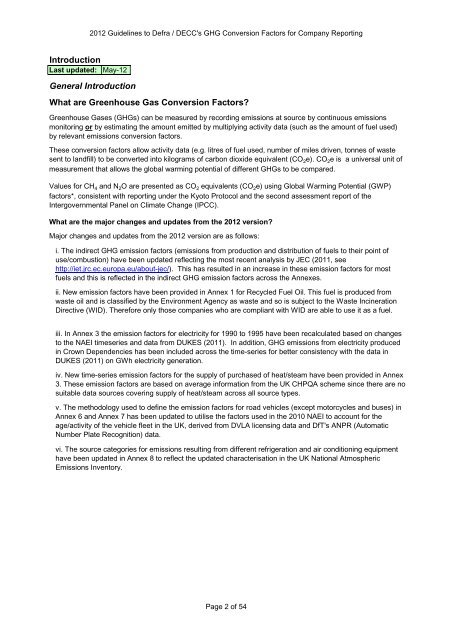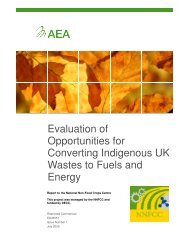Greenhouse gas conversion factors for company reporting
Greenhouse gas conversion factors for company reporting
Greenhouse gas conversion factors for company reporting
You also want an ePaper? Increase the reach of your titles
YUMPU automatically turns print PDFs into web optimized ePapers that Google loves.
2012 Guidelines to Defra / DECC's GHG Conversion Factors <strong>for</strong> Company Reporting<br />
Introduction<br />
Last updated:<br />
May-12<br />
General Introduction<br />
What are <strong>Greenhouse</strong> Gas Conversion Factors?<br />
<strong>Greenhouse</strong> Gases (GHGs) can be measured by recording emissions at source by continuous emissions<br />
monitoring or by estimating the amount emitted by multiplying activity data (such as the amount of fuel used)<br />
by relevant emissions <strong>conversion</strong> <strong>factors</strong>.<br />
These <strong>conversion</strong> <strong>factors</strong> allow activity data (e.g. litres of fuel used, number of miles driven, tonnes of waste<br />
sent to landfill) to be converted into kilograms of carbon dioxide equivalent (CO 2 e). CO 2 e is a universal unit of<br />
measurement that allows the global warming potential of different GHGs to be compared.<br />
Values <strong>for</strong> CH 4 and N 2 O are presented as CO 2 equivalents (CO 2 e) using Global Warming Potential (GWP)<br />
<strong>factors</strong>*, consistent with <strong>reporting</strong> under the Kyoto Protocol and the second assessment report of the<br />
Intergovernmental Panel on Climate Change (IPCC).<br />
What are the major changes and updates from the 2012 version?<br />
Major changes and updates from the 2012 version are as follows:<br />
i. The indirect GHG emission <strong>factors</strong> (emissions from production and distribution of fuels to their point of<br />
use/combustion) have been updated reflecting the most recent analysis by JEC (2011, see<br />
http://iet.jrc.ec.europa.eu/about-jec/). This has resulted in an increase in these emission <strong>factors</strong> <strong>for</strong> most<br />
fuels and this is reflected in the indirect GHG emission <strong>factors</strong> across the Annexes.<br />
ii. New emission <strong>factors</strong> have been provided in Annex 1 <strong>for</strong> Recycled Fuel Oil. This fuel is produced from<br />
waste oil and is classified by the Environment Agency as waste and so is subject to the Waste Incineration<br />
Directive (WID). There<strong>for</strong>e only those companies who are compliant with WID are able to use it as a fuel.<br />
iii. In Annex 3 the emission <strong>factors</strong> <strong>for</strong> electricity <strong>for</strong> 1990 to 1995 have been recalculated based on changes<br />
to the NAEI timeseries and data from DUKES (2011). In addition, GHG emissions from electricity produced<br />
in Crown Dependencies has been included across the time-series <strong>for</strong> better consistency with the data in<br />
DUKES (2011) on GWh electricity generation.<br />
iv. New time-series emission <strong>factors</strong> <strong>for</strong> the supply of purchased of heat/steam have been provided in Annex<br />
3. These emission <strong>factors</strong> are based on average in<strong>for</strong>mation from the UK CHPQA scheme since there are no<br />
suitable data sources covering supply of heat/steam across all source types.<br />
v. The methodology used to define the emission <strong>factors</strong> <strong>for</strong> road vehicles (except motorcycles and buses) in<br />
Annex 6 and Annex 7 has been updated to utilise the <strong>factors</strong> used in the 2010 NAEI to account <strong>for</strong> the<br />
age/activity of the vehicle fleet in the UK, derived from DVLA licensing data and DfT's ANPR (Automatic<br />
Number Plate Recognition) data.<br />
vi. The source categories <strong>for</strong> emissions resulting from different refrigeration and air conditioning equipment<br />
have been updated in Annex 8 to reflect the updated characterisation in the UK National Atmospheric<br />
Emissions Inventory.<br />
Page 2 of 54








